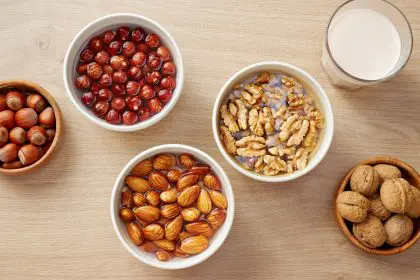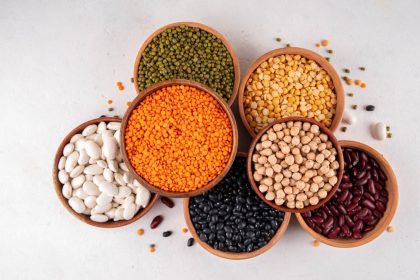Sugar consumption has reached epidemic levels in modern diets, contributing to numerous health problems including weight gain, diabetes, heart disease, and energy fluctuations that affect daily life quality. The average person consumes far more sugar than recommended, often without realizing how much hidden sugar exists in everyday foods and beverages.
Reducing sugar intake doesn’t require extreme measures or complete dietary overhauls that are difficult to maintain long-term. Simple, practical strategies can dramatically reduce sugar consumption while maintaining satisfying meals and snacks that support sustained energy levels and overall wellness.
The key to successful sugar reduction lies in understanding where sugar hides in common foods, developing practical substitution strategies, and creating sustainable habits that naturally lead to lower sugar intake without feeling deprived or restricted.
Start your morning with protein-rich breakfast choices
The first effective strategy for reducing daily sugar intake involves transforming breakfast habits away from sugar-laden cereals, pastries, and sweetened beverages toward protein-rich options that provide sustained energy without blood sugar spikes.
Traditional breakfast foods like sweetened cereals, flavored yogurts, muffins, and fruit juices can contain as much sugar as desserts, setting up a cycle of cravings and energy crashes throughout the day. Replacing these with eggs, plain Greek yogurt, nuts, seeds, or vegetables creates a stable foundation for balanced blood sugar.
Protein-rich breakfasts help regulate appetite hormones and reduce cravings for sugary snacks later in the day. This approach addresses sugar reduction proactively by preventing the physiological triggers that drive sugar seeking behaviors throughout the morning and afternoon hours.
Simple breakfast transformations include choosing plain oatmeal with fresh berries instead of flavored packets, selecting unsweetened yogurt with added nuts rather than fruit-flavored varieties, or preparing vegetable omelets instead of reaching for quick pastry options.
Master the art of reading ingredient labels carefully
The second crucial strategy involves developing skills to identify hidden sugars in packaged foods by learning to read ingredient labels effectively. Sugar appears under dozens of different names on food labels, making it easy to consume large amounts without awareness.
Common sugar aliases include high fructose corn syrup, cane juice, brown rice syrup, agave nectar, dextrose, maltose, and many others that disguise the presence of added sweeteners in products that may not taste particularly sweet.
Ingredient lists are arranged by weight, so sugars appearing in the first few ingredients indicate significant sugar content. Products with multiple types of sugar spread throughout the ingredient list can have surprisingly high total sugar content even when individual sugars appear lower on the list.
Developing label reading habits helps identify which products to avoid and reveals lower-sugar alternatives that may be available from different brands or product lines within the same food categories.
Replace sugary beverages with naturally flavored alternatives
The third powerful approach focuses on eliminating liquid calories from sugary drinks, which represent one of the largest sources of added sugar in most people’s diets. Beverages like soda, fruit juices, energy drinks, and sweetened coffee drinks can contain enormous amounts of sugar in forms that don’t provide satiety.
Water infused with fresh fruits, herbs, or vegetables provides refreshing flavor without added sugars while supporting proper hydration. Cucumber mint water, lemon lime combinations, or berry-infused water offer appealing alternatives to commercial flavored drinks.
Unsweetened herbal teas, both hot and iced, provide variety and flavor without contributing sugar calories. Green tea, chamomile, peppermint, and fruit-flavored herbal teas satisfy the desire for flavorful beverages while supporting overall health goals.
Sparkling water with fresh citrus juice or a splash of 100% fruit juice creates satisfying alternatives to soda without the excessive sugar content found in commercial soft drinks and flavored beverages.
Transform your snacking habits with whole food options
The fourth strategy involves replacing processed snack foods with whole food alternatives that provide nutrition and satisfaction without added sugars. Many commercial snacks contain hidden sugars even in products that seem healthy or savory.
Fresh fruits paired with nuts or seeds provide natural sweetness along with protein, healthy fats, and fiber that create lasting satisfaction. Apple slices with almond butter, berries with plain yogurt, or grapes with cheese offer balanced nutrition without processed sugars.
Vegetable-based snacks like carrot sticks with hummus, bell pepper strips with guacamole, or cucumber slices with tahini provide satisfying crunch and flavor while contributing valuable nutrients without sugar spikes.
Preparing homemade trail mixes with unsweetened nuts, seeds, and small amounts of dried fruit allows control over sugar content while creating portable snacks that support energy levels throughout busy days.
Cook more meals at home using fresh ingredients
The fifth effective approach involves increasing home cooking frequency to gain complete control over sugar content in meals. Restaurant foods and prepared meals often contain surprising amounts of added sugar in sauces, marinades, and seasonings.
Home cooking allows experimentation with herbs, spices, and natural flavor enhancers that create satisfying meals without relying on sugar for taste appeal. Garlic, ginger, citrus, vinegars, and fresh herbs provide complex flavors that eliminate the need for sweet additives.
Batch cooking and meal preparation strategies make home cooking more convenient and reduce reliance on processed foods that typically contain hidden sugars. Preparing proteins, vegetables, and grains in advance creates building blocks for quick, healthy meals throughout busy weeks.
Simple cooking techniques like roasting vegetables, grilling proteins, and creating herb-based sauces provide satisfying meals that naturally avoid the sugar content found in many commercial food preparations.
Choose naturally sweet foods over processed alternatives
The sixth strategy focuses on satisfying sweet cravings with whole foods that provide natural sugars along with beneficial nutrients, fiber, and compounds that help regulate blood sugar response. This approach addresses sugar cravings without completely eliminating sweetness from the diet.
Fresh fruits provide natural sweetness along with vitamins, minerals, antioxidants, and fiber that slow sugar absorption and provide lasting satisfaction. Berries, apples, pears, and citrus fruits offer lower sugar options compared to tropical fruits and dried varieties.
Dates, when used sparingly, can satisfy intense sweet cravings while providing minerals and fiber. A few dates stuffed with nuts create a satisfying treat that provides more nutrition than processed candy or desserts.
Sweet vegetables like carrots, beets, sweet potatoes, and winter squashes provide natural sweetness along with valuable nutrients. Roasting these vegetables concentrates their natural sugars and creates satisfying side dishes or snack options.
Modify your coffee and tea preparation methods
The seventh approach involves transforming beverage habits by reducing or eliminating added sugars in coffee and tea preparations. These daily beverages can contribute significant sugar intake when prepared with syrups, flavored creamers, or multiple teaspoons of sugar.
Gradually reducing sugar amounts in coffee and tea allows taste preferences to adapt naturally over time. Most people find they can appreciate the natural flavors of quality coffee and tea when sugar quantities are slowly decreased over several weeks.
Unsweetened plant-based milks, a dash of cinnamon, or a drop of vanilla extract can enhance coffee flavor without adding sugar. These natural flavor enhancers provide variety and satisfaction while supporting sugar reduction goals.
Cold brew coffee and high-quality loose leaf teas often have naturally smoother, less bitter flavors that require less sweetening than conventional preparation methods, making the transition to unsweetened beverages easier and more enjoyable.
Plan and prepare satisfying sugar-free desserts
The eighth strategy involves creating healthier dessert options that satisfy sweet cravings without relying on refined sugars. This approach prevents feelings of deprivation that can lead to sugar binges while supporting long-term dietary changes.
Fruit-based desserts like baked apples with cinnamon, berry parfaits with unsweetened yogurt, or frozen banana “ice cream” provide natural sweetness and satisfying textures that fulfill dessert desires without processed sugars.
Dark chocolate with high cacao content provides rich satisfaction with less sugar than milk chocolate varieties. Small portions of quality dark chocolate can satisfy chocolate cravings while providing beneficial antioxidants and minerals.
Homemade energy balls made with dates, nuts, and seeds create portable sweet treats that provide sustained energy rather than sugar crashes. These preparations allow complete control over ingredients and sugar content.
Understand and manage sugar craving triggers
The ninth crucial approach involves identifying personal triggers that lead to sugar cravings and developing alternative responses that don’t involve food. Many sugar cravings stem from emotional, environmental, or physiological triggers rather than true hunger.
Stress, boredom, fatigue, and emotional states often trigger desires for sugary foods as a coping mechanism. Developing alternative stress management techniques like deep breathing, short walks, or brief meditation can address these triggers without food involvement.
Blood sugar fluctuations from skipping meals or eating unbalanced meals can create intense sugar cravings. Maintaining regular meal schedules with balanced macronutrients helps prevent the physiological conditions that drive sugar seeking behaviors.
Environmental triggers like seeing attractive displays of sugary foods or following habitual patterns can be managed through route planning, environmental modifications, and conscious habit replacement strategies.
Optimize your sleep and stress management routines
The tenth strategy recognizes the crucial connections between sleep quality, stress levels, and sugar cravings. Poor sleep and chronic stress create hormonal imbalances that increase desires for quick energy from sugary foods.
Adequate sleep supports proper regulation of hunger hormones and reduces cortisol levels that can drive sugar cravings. Establishing consistent sleep schedules and creating conducive sleep environments helps maintain the hormonal balance necessary for healthy food choices.
Stress management techniques like regular exercise, meditation, journaling, or hobby engagement provide alternative methods for managing emotions without turning to sugary comfort foods. These practices address root causes of stress-driven eating patterns.
Regular physical activity helps regulate blood sugar levels, improves mood, and reduces stress hormones that can trigger sugar cravings. Even brief daily walks or gentle movement practices can significantly impact sugar consumption patterns.
Create supportive social and environmental conditions
The eleventh approach involves modifying social and environmental factors that influence sugar consumption patterns. The people and places that surround daily life significantly impact food choices and can either support or undermine sugar reduction efforts.
Removing sugary foods from easily accessible locations in homes and workplaces reduces impulsive consumption that often occurs without conscious decision making. Replacing these items with healthier alternatives makes good choices more convenient than poor ones.
Communicating dietary goals with family members and friends creates social support systems that reinforce healthy choices rather than sabotaging them. Many social situations revolve around sugary foods, so having supportive relationships helps navigate these challenges.
Identifying and avoiding or modifying environments that trigger sugar consumption helps prevent situations where willpower alone must overcome environmental pressures to consume sugary foods.
Develop mindful eating practices and awareness
The twelfth strategy focuses on cultivating awareness around eating habits and developing mindful approaches that naturally reduce sugar consumption through increased consciousness about food choices and eating patterns.
Eating without distractions like television or phones increases awareness of taste, texture, and satisfaction levels, often revealing that smaller amounts of sweet foods provide adequate satisfaction when consumed mindfully.
Paying attention to physical hunger and satiety cues helps distinguish between true hunger and emotional or habitual eating that often involves sugary foods. This awareness prevents mindless consumption that doesn’t serve nutritional or satisfaction needs.
Practicing gratitude and appreciation for food quality rather than quantity helps shift focus toward nutrient density and satisfaction rather than seeking quick energy from sugary options.
Learn effective sugar substitution techniques
The thirteenth approach involves mastering healthy substitution methods that maintain food enjoyment while dramatically reducing sugar content in favorite recipes and meal preparations.
Natural flavor enhancers like vanilla extract, almond extract, cinnamon, nutmeg, and citrus zest can provide sweetness perception without adding sugar calories. These ingredients trick taste perception while providing complex flavors that enhance overall food satisfaction.
Small amounts of naturally sweet ingredients like unsweetened applesauce, mashed banana, or date paste can replace larger quantities of refined sugar in baking and cooking applications while adding nutritional value.
Experimenting with spice combinations that create warmth and complexity helps reduce reliance on sugar for flavor satisfaction. Combinations like cinnamon and cardamom or ginger and cloves provide rich taste experiences without sweeteners.
Build sustainable long-term dietary patterns
The fourteenth strategy emphasizes creating sustainable approaches that can be maintained long-term rather than pursuing extreme restrictions that lead to eventual rebound sugar consumption.
Gradual reduction approaches allow taste preferences to adapt naturally over time, making permanent changes more achievable than dramatic overnight transformations that feel restrictive and difficult to maintain.
Flexibility within structure allows for occasional treats and social situations while maintaining overall sugar reduction goals. This balanced approach prevents the all-or-nothing thinking that often derails dietary improvements.
Focus on adding beneficial foods rather than only restricting sugar creates a positive framework that emphasizes abundance rather than deprivation, making the process more enjoyable and sustainable over time.
Monitor progress and adjust strategies accordingly
The fifteenth and final strategy involves developing systems for tracking progress and making adjustments that optimize sugar reduction efforts based on individual responses and changing life circumstances.
Keeping simple food journals or using mobile apps helps identify patterns in sugar consumption and reveals which strategies are most effective for individual lifestyles and preferences.
Regular assessment of energy levels, mood, sleep quality, and overall well-being provides feedback about the effectiveness of sugar reduction efforts and helps maintain motivation during challenging periods.
Celebrating small victories and progress milestones helps maintain motivation while building confidence in the ability to make lasting dietary changes that support long-term health and wellness goals.
Creating your personalized sugar reduction plan
The most effective approach to reducing sugar intake involves selecting and combining strategies that align with individual lifestyles, preferences, and circumstances. Not every strategy will work equally well for every person, so experimentation and customization are essential for long-term success.
Starting with one or two strategies and gradually adding others prevents overwhelming changes that are difficult to maintain. Building momentum through small successes creates confidence and motivation for tackling more challenging aspects of sugar reduction.
Remember that reducing sugar intake is a journey rather than a destination, with ongoing benefits that extend far beyond weight management to include improved energy levels, better mood stability, and reduced risk of chronic diseases.
Your commitment to reducing sugar intake represents an investment in long-term health and vitality that will pay dividends in energy, wellness, and quality of life for years to come.













